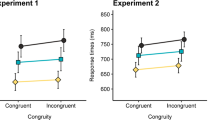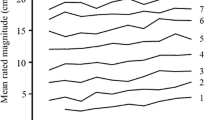Abstract
Letter series and number series tests, comprising items based on identical rules, were administered in a counterbalanced design to 320 undergraduates in order to determine the similarity of factorial structure by means of Tucker’s coefficients of congruence. Results indicated that the letter and number series tests, in which each item in one had a same-rule counter-part in the other, possessed limited factorial similarity because only 4 of the 8 identically constituted factors yielded coefficients of congruence between .80 and .91 (median = .85). Examination of item-wise patterns of responses of the persons, whose total scores on the letter series tests were five or more points lower than their total scores on the corresponding number series tests, revealed certain tactics of this group (n = 92) that might account for the lack of adequate factorial similarity.
Similar content being viewed by others
References
Butterfield, E. C., Nielsen, D., Tangen, K. L., & Richardson, M. B. (1985). Theoretically based psychomet-ric measures of inductive reasoning. In. S. E. Embretson (Ed.), Test design: Developments in psychology and psychometrics. New York:Academic.
Erstad, D. (1988). The comparability of WAIS and WAIS-R for ages 60-90. Unpublished master’s thesis, Marquette University, Milwaukee, WI.
Quereshi, M. Y. (1960). Mental test performance as a function of payoff conditions, item difficulty, and degree of speeding. Journal of Applied Psychology, 44, 65–77.
Quereshi, M. Y., & Fisher, T. L. (1977). Logical versus empirical estimates of item difficulty. Educational and Psychological Measurement, 37, 91–100.
Quereshi, M. Y., & Ostrowski, M. J. (1985). The comparability of three Wechsler Adult Intelligence Scales in a college sample. Journal of Clinical Psychology, 41, 308–407.
Quereshi, M. Y., & Seitz, R. (1993). Identical rules do not make letter and number series equivalent. Intelligence, 17, 399–405.
Quereshi, M. Y., & Smith, H. (1998). Reasoning ability in older adults measured through letter and number series. Current Psychology. 17, 20–27.
Schieffer, B. (1994). Gender differences in the completion of sequential reasoning patterns. Unpublished
Author information
Authors and Affiliations
Rights and permissions
About this article
Cite this article
Quereshi, M.Y. Factorial similarity of letter and number series comprising identical rules. Curr Psychol 20, 278–286 (2001). https://doi.org/10.1007/s12144-001-1012-5
Accepted:
Issue Date:
DOI: https://doi.org/10.1007/s12144-001-1012-5




